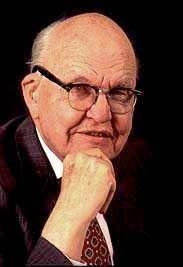 |
Ever since the 17th century mankind has sought ways of processing and delivering information as quickly and reliably as possible. Anyone who has operated a hand held calculator is a benefactor of mankind's insatiable appetite for the dissemination and control of information.
Into this quest stepped Jack St. Clair Kilby, co-inventor (with Robert Noyce) of the microchip. With Kilby's invention the world of circuits made a quantum leap, and its effects are so far reaching that capabilities of the computer you are reading this on would be extremely limited if not for his invention.
A large man at 6'6" but personally unassuming, Kilby grew up in Kansas. Kilby's father, an electrical engineer who became the president of the Kansas Power Company, was fond of bringing Jack along on his many trips and site visits to power facilities and generation stations in Western Kansas. During such outings, no doubt, the wonders and limitations of electricity and its conduction was not lost on Jack Kilby.
Kilby first became aware of the possibilities and limitations of the integration of circuits during the age of transistors and vacuum tubes. Kilby reasoned that, in order for information to be processed in an evolutionary way, there would have to be a solution for what was then called the Tyranny of Numbers.
In short, this tyranny was a dilemma brought about by the use of vacuum tubes and transistors (both the prevalent components of information processing machines at the time). Since vacuum tubes were short- lived and ran very hot, and transistors demanded numerous interconnections to be adequately assembled by hand, both were considered impractical, numerically, for the production of reliable complex components.
In 1958 Kilby joined Texas Instruments during the onset of the company's tradition of company-wide summer vacation. Kilby was too new to partake of vacation time so he got to work. With the TI lab completely to himself, Kilby's work led him to the belief that all parts of a circuit should be made of the same material: silicon.
Silicon was plentiful, had proven itself as a viable semiconductor, and worked well under intense heat. By using one material instead of many Kilby believed that complicated and numerous wiring of circuitry could be avoided. He was correct. The brilliance of Kilby's idea lies in the fact that it allowed a way by which many components could be put onto one tiny chip. Here Kilby begins his assault on the Tyranny of Numbers problem that had loomed for so many engineers and inventors.
On June 23, 1964, patent #3,138,743 was filed under the name Jack Kilby with the Commissioner of Patents. It was a patent for the integrated circuit. Although crude by current standards the prototype that led to this patent would soon hasten the dawn of the hand held calculator, the laptop computer, and the digital age.
One of the many seemingly anonymous heroes in the quest for information evolution, Jack Kilby considers himself, first and foremost, an engineer. Ironically, Kilby prefers a slide rule to the calculator, which it so brilliantly displaced! Among many of the patents granted to Kilby during his time at Texas Instruments is the thermal printing system. This a system by which a printer head "burns" images onto heat sensitive paper.
Today, information is conducted through circuits at speeds undreamed of when Kilby went to work in an empty lab at Texas Instruments in 1958. The quest for faster processing, circuit performance, and information delivery evolves as the digital age of the semi-conductor ripens.
It can never be denied that the fastest and most complex computer owes a great debt to this man-this unassuming man from Kansas. Quiet and methodical, Kilby was a man never far from his analog watch and his beloved slide rule.
Page created on 5/29/2007 1:40:22 PM
Last edited 11/6/2019 7:18:45 PM
